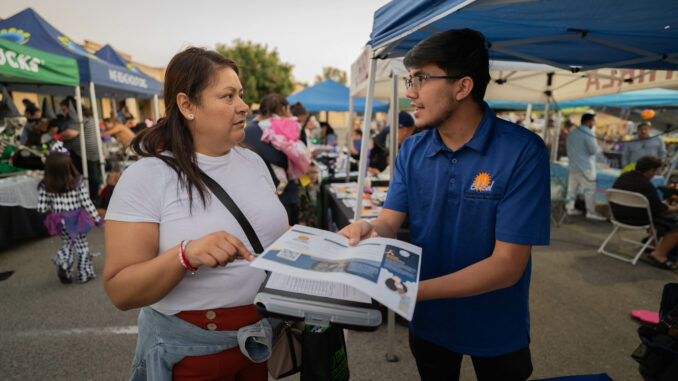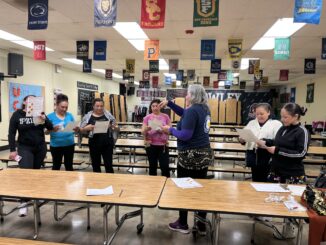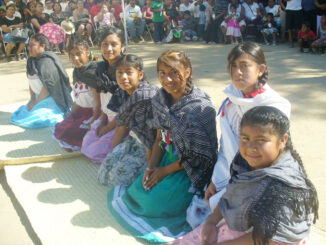
El Sol helps communities brace for emergencies, including wildfires and lingering smoke
by Anne Stokes
Wildfires leave behind more than scarred landscapes and burnt remnants. The resulting smoke, ash and toxic chemicals can travel hundreds of miles and cause health problems including eye and lung irritation, headaches, tiredness, and chest pain. For people in sensitive groups—young children, the elderly, those with chronic conditions like asthma, diabetes, heart or renal disease—the risks are much greater, and include fatal asthma attacks, heart failure and premature death.
When disasters strike, low-income communities are hit hardest. Many households can’t afford disaster preparedness measures like fire insurance, evacuation and transportation costs. They also can’t afford time off work.
“I think the Latino community, most of them, they need to go to work. They cannot work from home,” says Alexander Fajardo, executive director of El Sol Neighborhood Educational Center. “If they don’t go, they don’t put food on the table.”
“Everything we do is with community health workers and promotoras, they’re the ones who are in the community, doing the outreach, education, navigation and supporting communities through difficult times.”
Alexander Fajardo, Executive director, El Sol Neighborhood Educational Center
In the Inland Empire, El Sol has been working to mitigate health care disparities since 1991. Through their community health worker (CHW) and Promotores de Salud programs, they provide health education, preventative care outreach, early intervention and provider referrals to vulnerable and underserved communities. As members of those same communities, CHWs and promotores rely on their understanding of culture, language and history to connect with those they serve.
“Everything we do is with community health workers and promotoras, they’re the ones who are in the community, doing the outreach, education, navigation and supporting communities through difficult times,” says Fajardo.
As a volunteer CHW with El Sol, Giselle Posada says it’s her passion to educate her community, including helping people prepare for disasters like the recent Los Angeles wildfires. From working with the community, she says that many people have suffered from the resulting smoke and airborne ash that’s drifted eastward.
“Their respiratory system is getting affected. There’s less people coming out of their houses because of the possible health risks, especially the elderly or those with pre-existing health conditions,” she says. “Children are missing out on school due to parents not wanting to expose them to poor air quality. Then they’re having to leave work in order to care for their children.”
In partnership with the California Governor’s Office of Emergency Services (Cal OES) and its Listos California Emergency Preparedness Campaign, El Sol has been able to reach vulnerable communities with disaster preparedness resources for emergencies like fire, flood, earthquakes and other disasters. Cal OES programs like Listos California, and Ready Reps, focused on peer-to-peer community outreach, give organizations the resources and messaging needed to keep their communities safe. With such support, they’ve been able to develop and make good use of outreach materials like videos, trainings, games and an emergency guide that provides clear, actionable information in multiple languages.
While sometimes creating an emergency plan and knowing what to pack in a to-go bag or stay-box may seem complicated, Posada’s advice is to take things one step at a time.
“Little by little, you start packing your bag, because it can seem like a big task when we’re busy with life,” she says. “As the wise ants prepare their supplies and food in the summer, we too can prepare right now for the future.”
For more information on El Sol Neighborhood Educational Center and how they can help, visit www.elsolnec.org.
Finding Fresh Air
- Sign up for Alerts, sign up at ListosCalifornia.org/Alerts
- Stay inside and reduce activity. Keep doors and windows closed and do not run air conditioner
- Do NOT burn candles, propane or gas. Do not fry or broil meat, smoke or vape tobacco or vacuum inside
- Use a portable air cleaner with high-efficiency HEPA filters to create a clean room. Do not use an ozone-generating air cleaner
- Use respirators with the words “NIOSH” and either “N95” or “P100” printed on them. They must have a snug fit
- Stock up on medications, water and groceries that need neither refrigeration nor cooking
To help families and individuals plan for emergencies, Cal OES offers a readiness guide, which can be found at www.caloes.ca.gov for more information and tips on how to stay safe.




